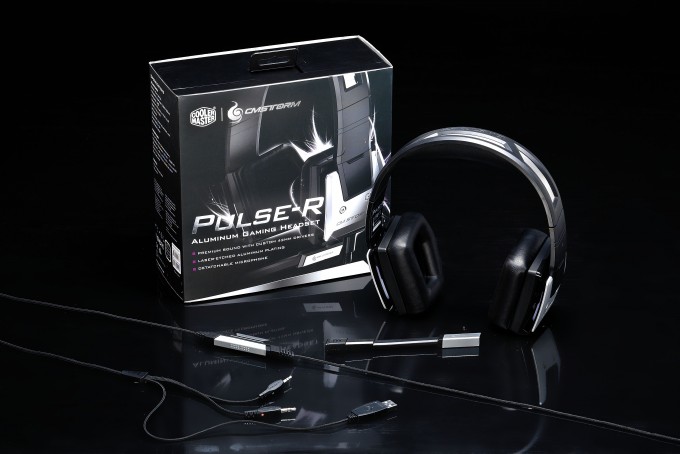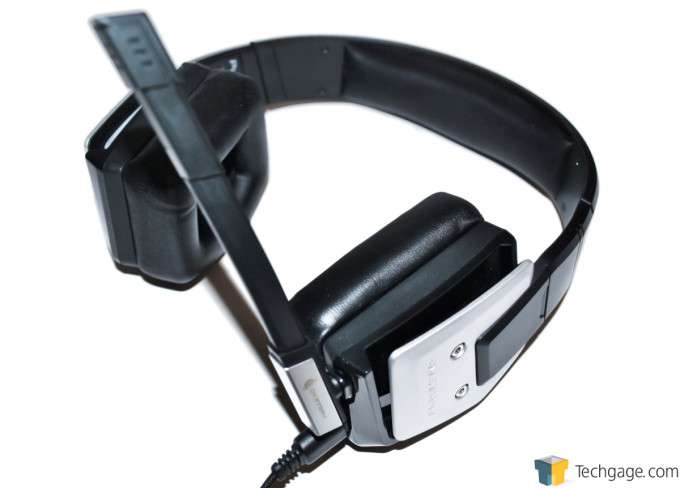- Qualcomm Launches Snapdragon 4 Gen 2 Mobile Platform
- AMD Launches Ryzen PRO 7000 Series Mobile & Desktop Platform
- Intel Launches Sleek Single-Slot Arc Pro A60 Workstation Graphics Card
- NVIDIA Announces Latest Ada Lovelace Additions: GeForce RTX 4060 Ti & RTX 4060
- Maxon Redshift With AMD Radeon GPU Rendering Support Now Available
CM Storm Pulse-R Aluminum Gaming Headset Review

Killer looks? Check. Detachable microphone? Check. Detachable cable? Check. Bling? Check! Customizable ear cup panels? Check. On the surface, CM’s Storm Pulse-R gaming headset ticks all of the right boxes as a LAN-ready, eSports-oriented stereo headset. But what is it like to live and play with? Let’s put them on and find out.
Page 2 – Performance Testing & Final Thoughts
I tested the Pulse-R in various scenarios, including gaming, movies, and music playback, to get a good picture of its sound signature. I also tested its microphone’s capabilities by using it in Skype. Finally, I also evaluated its ergonomics and aesthetics. By the end, we’ll have a good picture of what it’s like to live with – and play with – the Pulse-R.
First, a complimentary comment: I love the fact that, despite the three-piece presentation, the Pulse-R is a simple stereo headset. That means it doesn’t need any drivers or software. It’s plug-and-play all the way.
Now, some observations whilst gaming. The Pulse-R is unashamedly a gaming headset, so I wasn’t surprised to discover there is much to like when it’s used for that purpose. For one thing, its sound signature is heavily biased towards the bass end of the scale. Consequently, low frequency sounds really stand out. Big explosions in FPSes like Crysis 2 and Crysis 3, Call of Duty: Modern Warfare 3, and Battlefield 3 are particularly satisfying: They rumble without distortion, even at higher volume levels. The bias for low frequency sounds endows gaming sounds with a certain “bigness.” It’s a pleasant effect that’s unique to this headset. Positional audio is also quite good, certainly no worse nor no better than other stereo headsets/headphones I’ve used. The “limitation” to just two drivers is no such thing, as it’s still easy to tell where enemies, vehicles, and weapons discharges are relative to your in-game character’s position.
In movies, the Pulse-R performs much as it does in gaming. Its bias for bass emphasizes sounds from that end of the scale. But where the effect in games is pleasant, it is less so in movies. The biggest problem is in dialogue-heavy portions of the soundtrack: Voices sound unnatural, thicker and heavier than they should. It’s a psychological effect, but it’s no less distracting. Also, low-amplitude high-frequency sounds are simply overwhelmed: The bass sounds just dominate, and you can’t hear quieter higher-pitched sounds. On the positive side, it’s still quite good with sounds that pan from side-to-side; you can easily track spacecraft that fly across the screen, or that artillery shell that goes over the camera traveling diagonally from right to left.
While I prefer stereo when it comes to music playback, the Pulse-R leaves me a little miffed. Again, I blame the bass bias. Songs like the Foo Fighters’ Ain’t It The Life or the Byrds’ rendition of Hey Mr. Tambourine Man have guitar bits that should sound sparkly and bright; on the Pulse-R, these treble notes sound dark and thick and muddled. On orchestral tracks, the Pulse-R tends to bury violins and flutes, bells and triangles, and other high-register instruments under an avalanche of heavier and darker sounds. Familiar songs played back through neutral monitor headphones such as my aforementioned Shure SRH840s take on an unpleasantly dark and weighty aspect on the Pulse-R. On the other hand, play a tune like Sweet Emotion by Aerosmith or Ben E. King’s classic rendition of Stand By Me, you’d likely love the emphasis on the bottom end. Here’s the bottom line (pun intended), when it comes to the Pulse-R’s performance in music playback: Bass-heads would likely love the Pulse-R for its bass-bias, but listeners looking for nuance and precision really should look elsewhere.
Going on to the Pulse-R’s microphone, the long and short of things is that it works fine. Skype conversations using the Pulse-R revealed zero issues. According to my conversation partners, my voice came through clear and distortion-free, which is a great thing indeed.

Ergonomically, the Pulse-R is mostly comfortable. The ear cups’ thick padding aids the aluminum headband in keeping the headset on my melon with ease. The fit never feels too tight after the first couple of times using it – perhaps the aluminum headband needed to “memorize” the bend required for my head. Whatever the explanation, the Pulse-R will surely fit well on any end-user’s head.
Unfortunately, there are some ergonomic niggles to report. Chief amongst these is the thick padding on the ear cups retains a lot of body heat. After just thirty minutes or so, my ears are fairly hot and moist, necessitating a break to give the Pulse-R’s ear pieces (and my ears!) a wipe. Of course, right now it’s summer in SoCal where I am; although it’s really been a mild season, sometimes it gets up to 83°F in my apartment, and that’s enough to get my ears sweaty. Then again, I can’t say I can recall any of my other headsets/headphones (my collection of these rivals my keyboard collection) giving me similar issues.
Another slight complaint I’ll make might just be unique to my ears: The ear cups seem just a touch too small. Ideally, the entire ear should sit inside the padded area of the ear cup. With the Pulse-R, though, part of my ear is pinched by the ear cup’s padding. I don’t really have ears the size of an African elephant’s, but it’s a little curious that the Pulse-R is the only headphone/headset that has ear cups that are just a mite undersized for my ears.
One final comment that is neither a word of praise nor a complaint has to do with the Pulse-R’s prevalent use of aluminum in its construction. The headband is purely aluminum sheathed in some plastic and leather, while the ear cups have aluminum plates on the outside. All this metal has a certain amount of mass; you will feel it on your head and neck. It won’t cause your neck muscles to break out in spasms (something else did that to me), but you will feel the Pulse-R’s presence while you’ve got it on.
Aesthetically, the Pulse-R is eye-catching. I like how its visual styling is distinct from its CM Storm headset relatives. The asymmetrical pentagons of the ear cups are unique to this headset, and the beveled aluminum plates only accentuate that shape. The color scheme of black and aluminum exude a certain “tech-y” vibe, as well. The whole thing somewhat reminds me of a 1980s DMC DeLorean.
That DeLorean flavor only gets more pronounced once you plug this thing into a USB port, thereby activating the white LEDs secreted in the ear cups and in the inline control box on the cable. I can almost hear Doc Brown say, “Once this sucker hits 88mph, you’re gonna see some serious $#17.”
So what’s the verdict on the CM Storm Pulse-R? It’s visually distinctive and arresting, sure. It’s one of the very few gaming headsets that features LED bling, detachable cable, and removable microphone. You can customize its signature aluminum ear cup plates however you want. It’s fairly comfortable to use, smallish ear cups notwithstanding. I love how you don’t need any drivers or software to use it. It’s very good when used in gaming, for sure. Given its $89.99 MSRP, though, I think it’s a little too specialized. You will have to put up with some fairly big compromises when it comes to its bass-biased sound signature. Its performance in movies isn’t as good as it should have been, and unless you only listen to the thump and boom of heavy bass in your musical preferences this wouldn’t be a headset I would recommend for you. Its strong emphasis on the bottom end means that the bottom line for the Pulse-R is less than favorable than it could have been.
I guess it all comes down to how you intend to use the Pulse-R: If you want a superb stereo headset to use just for gaming, it’s a good buy. If you want something that can be used for movies and music as well, it’s possible you might wind up being a bit disappointed.
Pros
- No drivers or software needed
- Visually distinctive
- Good construction and materials
- Very good performance in gaming
- Scope for customization
- Bling (LEDs) (if you’re into that sort of thing)
- Microphone with zero issues
Cons
- Very heavy, dark, bass-biased sound signature (compromises movie and music playback performance)
- Thick ear cup padding traps body heat
- Price, given its one-note gaming specialization
Support our efforts! With ad revenue at an all-time low for written websites, we're relying more than ever on reader support to help us continue putting so much effort into this type of content. You can support us by becoming a Patron, or by using our Amazon shopping affiliate links listed through our articles. Thanks for your support!





